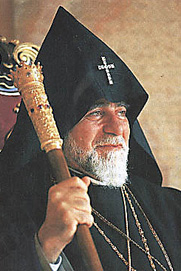
182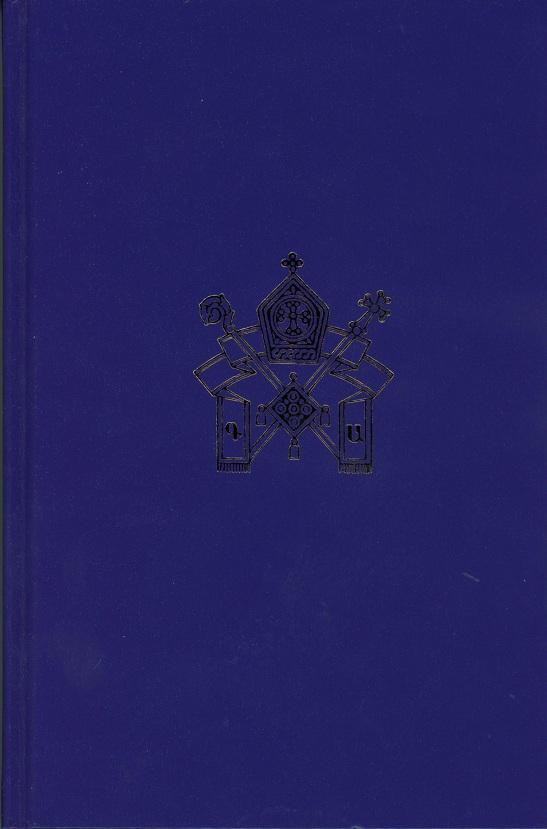 Rangement général
 | | Building Bridges - The Ecumenical Journey of Karekin I |
| Titre : | Building Bridges - The Ecumenical Journey of Karekin I / auteur(s) : Karekin SARKISSIAN, Catholicos Karékin II (Antélias), puis I (Etchmiadzine) - |
|---|
| Editeur : | Karekin I theological and armenological studies series |
|---|
| Année : | 2004 |
|---|
| Imprimeur/Fabricant : | Canada |
|---|
| Description : | |
|---|
| Collection : | Karekin I Series |
|---|
| Notes : | |
|---|
| Autres auteurs : | |
|---|
| Sujets : | Armenian Church -- Ecumenism |
|---|
| ISBN : | |
|---|
| Lecture On-line : | non disponible |
|---|
Commentaire :PREFACE by ARAM I Catholicos of the Great House of CiliciaHis HOLINESS KAREKIN I THE INTELLECTUAL, TEACHER AND WRITER (TRANSLATED FROM ARMENIAN) This undertaking to present to the Armenian people the fruit of the mind and soul of Catholicos of All Armenians Karekin I in a complete collected series is not only highly commendable but also necessary. With his intellectual and spiritual insights, his scholarly investigations and philological works, His Holiness Karekin occupies a central place in our classical, theological, ecumenical and modern literature of the past half-century. Students and scholars specializing in these fields will certainly find much to excavate in the spiritual-intellectual gold mine left behind by His Holiness. The relationship and collaboration that I had with Catholicos Karekin, which continued for almost forty years, had a different quality, depth and character. I knew him well at all levels of his ministerial service. My relationship with him started out as that of pupil to teacher and developed into that of one Catholicos to another. Our relationship and collaboration, which was characterized by its unique nature, multifaceted dimensions and wide scope, would naturally make it possible for me to have an existential and comprehensive insight of His Holiness Karekin's person, his way of thinking and his inner world. And, finally, the complete knowledge of his person would dispose me to be charmed by his multifaceted virtues and merits, and this charm of his never dimmed. I am certain that when the contemporary history of the Armenian Church is written, His Holiness Karekin will be accorded a deserving place in the ranks of such lofty spiritual and intellectual figures as [Maghakia] Ormanian, [Yeghishe] Tourian, [Torkom Koushagian, and others. Within the narrow confines of these fev lines, as a personal testimony, I wish to focus on the three funda mental dimensions of His Holiness' person, life and service: tht intellectual, the teacher, and the writer. These constituted the foundation and spheres of His Holiness' life and service. These constituted the basic elements of the Catholicos' unique identity and the building blocks of his majesty, well before he ascended the catholicossal throne. Above and beyond everything else, His Holiness Karekin was an intellectual in the deepest and truest sense of the word. He was an intellectual of quality and distinct identity, with his unique way of thinking, his unique manner of addressing issues and unique style of expressing his views. His thinking had substance, depth and shades; his speech was so charming and his pen so rich with vivid feelings, fresh ideas and appealing images. It is true, sometimes he would give importance to form; his way of thinking was generally complex but his thoughts would spring abundantly, like limpid water, from the pure fountainheads of his mind and soul, often further enriched and crystallized by experiences from his life of service. He knew how to express profound thoughts in simple words and make literary inventions with ordinary forms of expression. His Holiness was endowed with exceptional thinking, speaking and writing gifts. Indeed, the simultaneous existence of these different aptitudes in him had rendered him a radiant and captivating personality. Catholicos Karekin was a quick thinker. He did not need a long time to understand the other person and formulate his reply. But his rare ability to think quickly and express himself with ease sometimes caused him to give less importance to the analytical aspect of his thinking, particularly in his written expressions. However, he would give sufficient time to his thinking intended to advance a point of view. Catholicos Karekin not only used to closely follow the evolution of international issues, developments taking place within various realms of society and, especially, our national, ecclesiastical and cultural life, but also had something to say about them. It was so pleasant to be with him, to listen to him in his office, while strolling or in an atmosphere of intimacy. It was in such context that the intellectual and clergyman with viewpoints, crises, visions and faith used to radiate with such authenticity, simplicity and immediacy. He used to approach people, the world, life and death, and the good and bad deriving from them, so seriously that even the smallest incident or occurrence pertaining to them would affect his emotional state and rationality. He was supersensitive, despite his effort to conceal it. He experienced a great deal of anxiety and agitation yet there were very few circumstances when he would share his concerns with those in his circle. These traits of his character had left a deep mark on his speech and writing. I will not have exaggerated if I say that Catholicos Karekin was an intellectual, starting from conception; he had a mind that was "given from above," a sharp, alert, penetrating and lucid mind. He did not have to gather the honey of his mind from flowers, like the bee. His Holiness, who was endowed with exceptional virtues, developed into and remained a tenacious reader. Books remained his closest friends, all the way from grammar school to the catholicossal throne. He not only praised the unique value of books; they became a permanent presence on his night table, in his briefcase, and on his desk too. The library was one of his most favorite places. Even during the course of his pontifical visits, he used to create opportunities to "secretly" visit that city's libraries and bookstores. Considering the quantity and quality of its books, the library he left behind bears eloquent witness to His Holiness' intimacy with books. I remember that, during the time when I was a pupil, the light in Father Karekin's office used to remain on until the late hours of the night, yet early every morning he would participate in the matins with us. This conduct had a very deep impact on our spiritual and intellectual formation. Father Karekin became a role model for all of us. Today, how many clergymen of the Armenian Church engage in such conduct?. . Every intellectual is not a teacher and every teacher is not an intellectual. Catholicos Karekin was both—supremely, totally and authentically. He executed his innate calling to share what he received, what he had, with others with the highest degree of zeal, devotion and commitment. He ever remained a "pupil," even on his pontifical throne; his thirst to know, get and read more was never sated. Along with remaining a pupil, he also became a teacher, one with faith and anguish, who undertook the initiative to impart spirit and vision. His promotion through the hierarchical ranks of the church never eclipsed the teacher in him; he never became removed from teaching, no matter the circumstances of his life. This solid fusion of intellectual and teacher became the source of His Holiness' strength, vitality and warmth. His Holiness was not the bookish kind of teacher who teaches a given subject solely according to its textbook. Often he would go beyond the narrow confines of the textbook and take his pupils into untrodden areas requiring inquiry and research; he would open wide horizons of reflection and analysis before them. He would always attempt to relate persons, events and ideas to present-day life. Thus, when he taught theology, he did not confine himself to metaphysical realms; rather, he directed his pupils toward living theology. When he spoke about the church fathers of the fifth century, he established a bridge connecting the fifth century to the present one. When he taught the history of the Armenian Church, his pupils felt that they too were participants in the centuries-old life and mission of the Armenian Church. His Holiness used to teach with feeling and conviction. Emotion, outburst, anguish and joy would succeed one another over the course of a few minutes. Indeed, Catholicos Karekin expressed the purest feelings, the truest emotions, the clearest thoughts and the deepest outbursts of his entire life and ministry, in the Seminary at Antelias; in other words, he gave the best, the truest and the most complete here. He put some of those on paper; some live in his pupils; many, alas! disappeared with his departure from this world. Unfortunately, the upheavals in his life and the new fields of service that opened to him in his post-Seminary years did not permit His Holiness to realize himself as intellectual and teacher with the same dynamism and consistency. Of course, like any other teacher, His Holiness also had his preferences and weaknesses. His love for Catholicos Zareh [Payaslian], Catholicos Karekin Hovsepiants, Catholicos Sahak Khabayian, and Patriarchs Tourian, Ormanian and Koushagian, all of whom were linked to our contemporary history, bordered on adoration. He had a special connection to, and zeal for, the Ecumenical Movement and high respect for the first Secretary of the World Council of Churches, Dr. Willem Visser't Hooft, who had been his godfather in ecumenism. For His Holiness Karekin, the preservation of our church's doctrine was an imperative necessity, despite his obvious flexibility and ecumenical spirit acquired from the inter-church movement. For him, Armenian culture was a sanctum; he considered it the sacred treasury of our faith, spiritual values and moral concepts. For him, our church, in turn, was sanctum sanctorum, for whose eternity he had the calling to prepare several new apostles. In the classroom, Catholicos Karekin was well liked by all pupils for his dynamic presence and captivating teaching style. He was not satisfied with seeing what he had given reproduced; he urged his pupils to go beyond the textbook and classroom, to inquire, investigate, compare, analyze and study. His Holiness was not only a teacher and lecturer, but also one who followed up with his pupils, pursued matters and demanded top performance. He always used to enter the classroom with books under his arm, and he rose to the lee-turn with a full, clear and bright mind. This meticulousness and self-preparation of his prompted him, even during the period when he was an archimandrite, to prepare his lectures in writing, particularly those pertaining to pastoral theology, doctrinal theology and church history. At a later stage of his life, he personally corrected the first of these three notebooks and published it. The second and third notebooks, containing classroom notes, still remain in rough form. It is my wish that some day a former pupil of his, who is familiar with his way of thinking and is well versed in the theology of our church, will review and publish these notes. The calling of teaching was so dominant in His Holiness' life of service that it was continued with the same dynamism even outside of the classroom. The teacher in him was evident in his sermons, messages and lectures, in terms of his way of thinking, the arrangement of his words, and his mode of expression. In fact, he used to approach his close associates and especially his former pupils at the Seminary like a teacher, sometimes consciously and sometimes unconsciously. Equally all of His Holiness' former pupils, regardless of their age or rank, used to approach him with reverence and gratitude. In his relationships, Catholicos Karekin always had something to give, like a teacher; like a pupil too, he would take what was coming to him and, in his unique style, he would enhance it with such delicacy and finesse that his capacity as teacher always emerged dominant. The serious intellectual and exemplary teacher could not help but become a writer too. Catholicos Karekin became the author of numerous small and large volumes. He did not write books with a preconceived plan. All his published works, with the exception of his two theses, are collections of his previously delivered sermons, lectures, messages and pontifical encyclicals, as well as feelings and concerns committed to paper, which he then assembled and arranged, generally based on theme, prior to publication. Now, it is necessary to view Catholicos Karekin's works from this perspective, and each volume must be evaluated in its own context. The publications bearing His Holiness' signature generally encompass the following main subjects: spiritual literature, church history, theology, Ecumenical Movement, Armenian culture and the mission of the Armenian Church. In my judgement, the work of Catholicos Karekin representing singular importance is his study entitled The Council of Chalcedon and the Armenian Church, which was written in English as his thesis for the B. Lit. degree from Oxford University. The Armenologist, theologian and scholarly philologist are a dominant presence in this serious study, which was prepared by Father Karekin when he was only 25 years old. Unfortunately, in the succeeding years, the administrative, spiritual and pastoral concerns and obligations that occupied him as bishop and then catholicos created neither the opportunity nor the atmosphere for him to carry out studies with the same quality, the same meticulousness and scope. That was a pity, and I said as much to His Holiness on a few occasions. We find that which characterizes Catholicos Karekin as intellectual and teacher clearly displayed in his works. It is important to stress that His Holiness' spiritual-intellectual legacy does not represent the entirety of the flights of his intellect, the palpitations of his heart and the sparks of his soul, his inner agitations and wranglings, the struggle of his faith, his worldview and inner world. There was more to Catholicos Karekin than what he gave, he could have given more but he was not able to do so. His extreme circumspection not only made him self-control led but also created a hedge around his thinking, speech and life, in general. Nevertheless, even under these conditions, he always remained a radiant personality. The intellectual output of Catholicos Karekin deserves great respect. He has made an important contribution to Armenology and, particularly, the history and theology of the Armenian Church. These then are the three shining beacons of Catholicos Karekin's life and service, which illuminated all the days of his life, injecting more light and hope, faith and vision in our collective life. As the pupil of Catholicos Karekin, I bow before the unfading memory of this great intellectual and model teacher, who distributed light for a full half century and today he has become light himself. ARAM I Catholicos of the Great House of Cilicia
April 25, 2003 Amelias, Lebanon |
248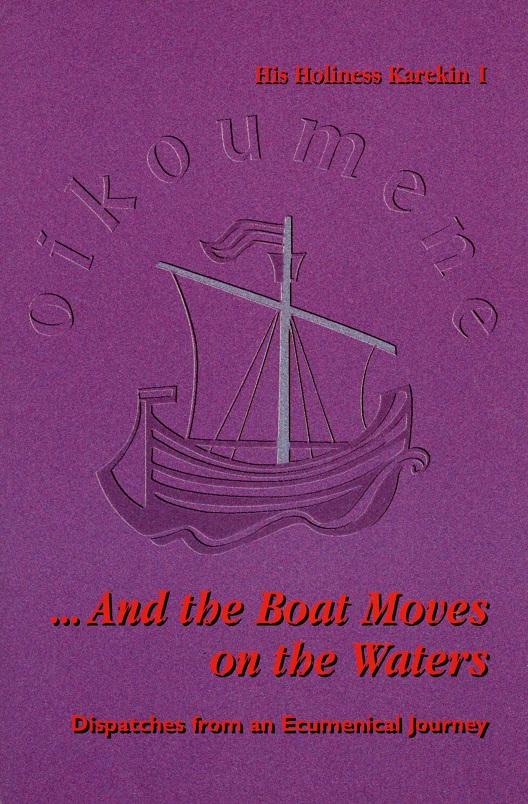 Rangement général
 | | And the Boat moves on the waters |
| Titre : | And the Boat moves on the waters / auteur(s) : Karekin SARKISSIAN, Catholicos Karékin II (Antélias), puis I (Etchmiadzine) - Dispatches from an ecumenical journey |
|---|
| Editeur : | St Vartan Press |
|---|
| Année : | 1998 |
|---|
| Imprimeur/Fabricant : | Printed in the United States |
|---|
| Description : | 15 x 23 cm, 200 pages, couverture illustrée en couleurs |
|---|
| Collection : | |
|---|
| Notes : | |
|---|
| Autres auteurs : | |
|---|
| Sujets : | Armenian Church -- Ecumenism |
|---|
| ISBN : | |
|---|
| Lecture On-line : | non disponible |
|---|
Commentaire :Texts from His Holiness Karekin I |
184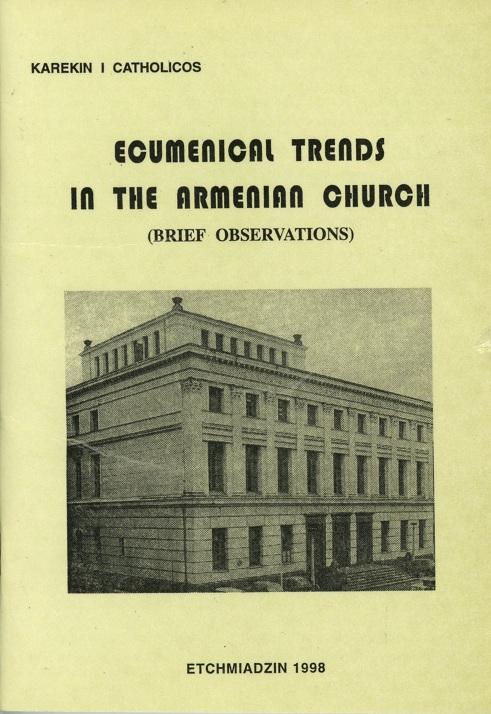 Rangement général
 | | Ecumenical Trends in the Armenian Church |
| Titre : | Ecumenical Trends in the Armenian Church / auteur(s) : Karekin SARKISSIAN, Catholicos Karékin II (Antélias), puis I (Etchmiadzine) - |
|---|
| Editeur : | Etchmiadzin |
|---|
| Année : | 1998 |
|---|
| Imprimeur/Fabricant : | Etchmiadzin |
|---|
| Description : | 14 x 20 cm, 24 pages, couverture illustrée en couleurs |
|---|
| Collection : | |
|---|
| Notes : | |
|---|
| Autres auteurs : | |
|---|
| Sujets : | Armenian Church -- Ecumenism |
|---|
| ISBN : | |
|---|
| Lecture On-line : | non disponible |
|---|
Commentaire :On 28th of January (1998) the Faculty of Theology of the Martin-Luther University Halle-Wittenberg, (Germany) by the decision of the Senate of the University bestowed upon His Holiness Karekin I, Catholicos of All Armenians, the academic distinction of Doctor Sacrosanctae Theologiae honoris causa.
On that solemn occasion His Holiness delivered his reception speech in which after thanking the University authorities he spoke on the Armenian Church by highlighting some ecumenical trends in the Armenian Church history. He underlined the specific aspect of the academic theological relations between the Theological Academy of Holy Etchmiadzin and the German universities and theological institutions and theologians, in the end of the 19th and the beginning of the 20th centuries. He advocated the pursuit and the promotion of such relationship for the present times. |
183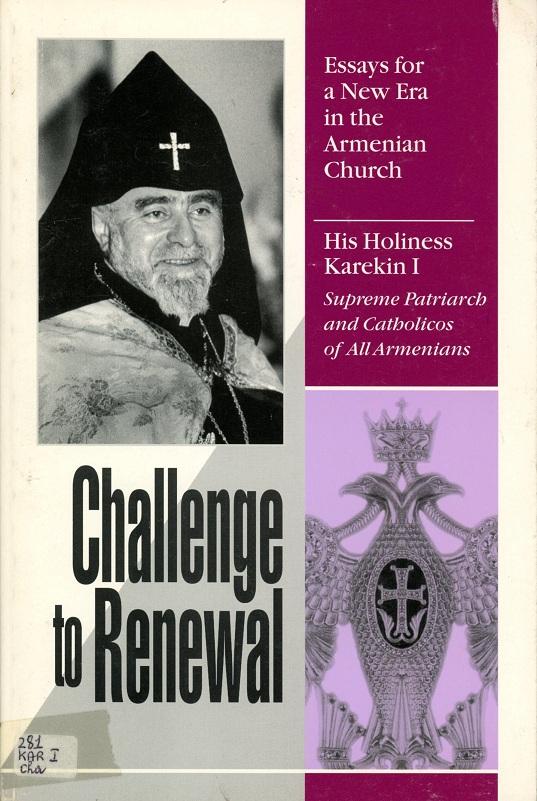 Rangement général
 | | Challenge to Renewal |
| Titre : | Challenge to Renewal / auteur(s) : Karekin SARKISSIAN, Catholicos Karékin II (Antélias), puis I (Etchmiadzine) - Essays for a new era in the Armenian Church |
|---|
| Editeur : | St. Vartan Press |
|---|
| Année : | 1996 |
|---|
| Imprimeur/Fabricant : | New York |
|---|
| Description : | 15,5 x 23 cm, 122 pages, couverture illustrée en couleurs |
|---|
| Collection : | |
|---|
| Notes : | |
|---|
| Autres auteurs : | |
|---|
| Sujets : | Armenian Church -- Ecumenism |
|---|
| ISBN : | |
|---|
| Lecture On-line : | non disponible |
|---|
Commentaire :On 28th of January (1998) the Faculty of Theology of the Martin-Luther University Halle-Wittenberg, (Germany) by the decision of the Senate of the University bestowed upon His Holiness Karekin I, Catholicos of All Armenians, the academic distinction of Doctor Sacrosanctae Theologiae honoris causa.
On that solemn occasion His Holiness delivered his reception speech in which after thanking the University authorities he spoke on the Armenian Church by highlighting some ecumenical trends in the Armenian Church history. He underlined the specific aspect of the academic theological relations between the Theological Academy of Holy Etchmiadzin and the German universities and theological institutions and theologians, in the end of the 19th and the beginning of the 20th centuries. He advocated the pursuit and the promotion of such relationship for the present times. |
398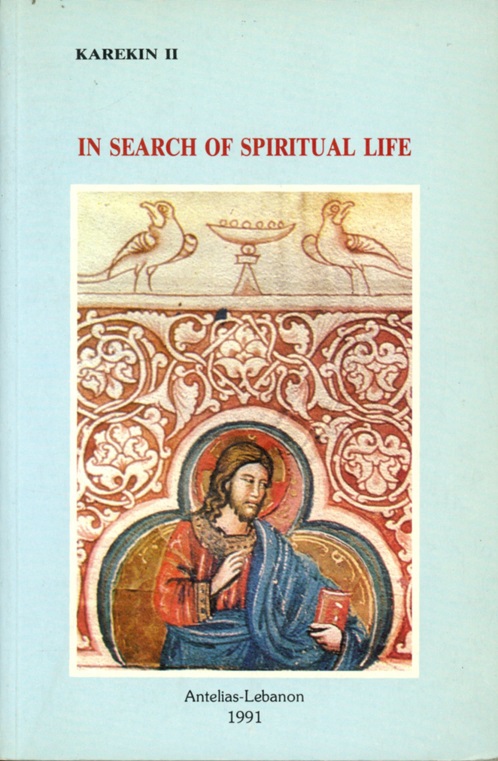 Rangement général
 | | In Search of spiritual life |
| Titre : | In Search of spiritual life / auteur(s) : Karekin SARKISSIAN, Catholicos Karékin II (Antélias), puis I (Etchmiadzine) - An Armenian Christian miscellany - Karekin II, Catholicos of Cilicia |
|---|
| Editeur : | Armenian Catholicosate of Cilicia, Antelias, Lebanon |
|---|
| Année : | 1991 |
|---|
| Imprimeur/Fabricant : | Printinh house of the Armenian Catholicosate of Cilicia |
|---|
| Description : | 14,5 x 21,5 cm, 285 pages, couverture illustrée en couleurs |
|---|
| Collection : | |
|---|
| Notes : | |
|---|
| Autres auteurs : | |
|---|
| Sujets : | Religion |
|---|
| ISBN : | |
|---|
| Lecture On-line : | non disponible |
|---|
Commentaire :CONTENTSForeword 7
PARTI CHRISTMAS: CALL TO REBIRTH
Christmas: Sunshine in Darkness 17
Bethlehem: The Sign-post to Life 23
With what Credentials? 27
Christmas: The Source and Prototype of all Gifts 35
"Thy Kingdom Come..." 41
The Imperative of Fellowship 47
"Blessed are the Peacemakers..." 53
In Search of the Truth 61
The Waters of Jordan in our Armenian Life 71
PART II AN ARMENIAN CHRISTIAN MISCELLANY
Called to Regeneration (Nicodemus and Us). . 81
Lent: A Journey into Christian Identity 89
Ecumenism: A Way of Renewal (A Testimony) . 101
The Wine and the Wineskins . 107
The Church: Our Life 115
Love, Prayer and Unity 123
Face to Face with Suffering 133
The Meaning of Wealth (In Everlasting Memory of Calouste Gulbenkian) 145
Living Martyrdom 153
Words from the Living to the Dead 157
The Bible in the Armenian Christian Tradition 169
True Reading of the Bible 183
How 1 See the Youth . 193
The World Council of Churches in its New Dimension, and the Orthodox Churches 207
"Living Hope" in a "Hopeless" Middle East 227
Church and Nation (General Remarks, with Special Reference to the Christian East) 243
Thousand Years of Pilgrimage to the Eternal 261
The Armenian Church Facing the 21st Century 269
FOREWORD During the years of my ministry in the Church, the preaching of the Word of God has occupied a central place in my service. It has given me a very special spiritual satisfaction because it has provided me with a constant opportunity of looking continuously and as deeply as possible in the Gospel and trying to discover the mind of Jesus for my own life and also for my asking others to do so. Is there a better, more profound and more authentic joy than the search for truth in and for one's own life?
It has thus become part of my experience to see that the kerigma is unseparable from koinonia and diaconia. They are not only and by nature inter-related, but also far richer when experienced in this their inter-relatedness in one's own understanding and vision of life.
On various occasions I had the chance of sharing such attempts with people and friends from such backgrounds which were not related solely to my own Armenian Church tradition. Ecumenical meetings, university student gatherings, commemorative events, festival days and celebrations, pastoral visitations, and other public functions presented me with opportunities to address people and to share with them the fruits of my readings and insights gained thereby. Some of such addresses were delivered on the basis of notes and later put into written form. Others were read on prepared texts; but in all cases they were intended to reach an audience in a particular setting and with a direct approach.
1. The first nine pieces constitute a series of sermon-type messages addressed to people within my spiritual jurisdiction in the Catholicosate of Cilicia, at Christmas time. Each tries to focus on one particular theme within the framework of the integral and uncon-sumable mystery of our Lord's incarnation. I believe that whatever we say or write about such mystery we will never be able to grasp its entire meaning which transcends our human understanding. We only can hint at this or that aspect of the unbounded spectrum of the manifestation of God's love in a person who became like us. identified himself with us, yet remaining above and beyond us, like the sun whose warmth and light we enjoy without being able to have it encompassed within the power and orbit of our sight.
2. The second part of the book is composed of such pieces which lack unity of theme and method of treatment. They were not designed for a book in the sense of elaborations on a particular subject. I would like to describe it, as the title of the whole book suggests. "An Armenian-Christian spiritual miscellany," a kind of 'Stromateis' to use a Patristic term.
Indeed. I have been fascinated, particularly in the last two decades of my life, by the spirit and character of the Patristic literature, in both the general Christian tradition and in Armenian Christian literary heritage.
Being mostly engaged in pastoral responsibilities, as Diocesan bishop and now as Catholicos, I discovered the special attraction of the literary legacy of the Church Fathers. What struck me very distinctively in this vast world of literary production was the fact that, generally speaking, the Church Fathers interpreted the Gospel message in the context of the life of the people of God. They addressed themselves to the particular situations of the people entrusted to their pastoral care. They faced the problems that arose in the concrete life of their people, who confronted conditions related to their environment of Judaic background, pagan religious cults, Graeco-Roman philosophies, popular beliefs and customs, social and moral behaviour, cultural traditions, manners and habits of life, gnostic and other heretical teachings, Roman empire's policies, inner dissensions and quarrels, etc. They did not elaborate or develop a particular doctrine with a speculative, scholarly or scientific approach and methodology, as later, particularly in the Scholastic age, people began to engage themselves often with such great pride and sense of academic excellence.
Books such as the 'Stromateis' of Clement of Alexandria and the Homilies of St. Gregory the Illuminator (nowadays ascribed to St. Mesrob Mashtots — 5th century) acquired a very special significance for me in this respect. Their writings provided me with such occasions of reading where I began to see even more clearly their knowledge and study of the Bible were related to their concern for special needs of the people. Knowledge and pastoralia, science and service, learning and teaching were thus inextricably interwoven.
I sense that this kind of treatment of the themes of our Christian faith is highly needed by the people who are desirous of reading and learning about the Gospel message. I often come across such articles and books which are heavily impregnated by highly intellectual, sophisticated, often speculative, theoretical, academic methods of elaboration. Many of them give me the impression of being cut off from the given context of the life of the people. Some of them are destined, as it were, to an elite, a kind of "club of experts" who argue with each other, within an inner circle, as if the subjects were their own end! In certain quarters, Partistic texts are amply quoted or referred to in order to justify one point of view or give the impression that the theses presented are sanctioned by the authority of the Fathers, besides the authority of the Holy Scriptures. Whereas the writings of the Church Fathers are mostly simple, straightforward expositions of the Gospel truth motivated by a concern of helping the people to understand their situations and their problems in the light of the Word of God.
This line of pastorally concerned presentation of the Christian faith is what the ordinary people need for their spiritual sustenance, moral conduct and relationship with people who necessarily do not share their understanding of the Christian faith and pattern of life.
I have tried to follow that path without however daring to reach the depth of the thought and insight of the Fathers whose power of faith and dedication is of such unique character and intensity.
3. A third series of writings is addressed to Armenian Church life and people, originally given in oral form on various occasions. They are intended to enhance in the consciousness of our own people, particularly the English speaking communities and groups, who are committedly engaged in Armenian present-day life and are eager to better understand their motivation and participation.
As one will easily discover, the themes in most cases are dealt with in an approach in which Christian and Armenian concerns are unseparably linked together.
Before I conclude this introductory and explanatory note, I should say that the pieces that are collected under this cover are far from encompassing all my writings in English on such subjects. There are still others that are kept out of the scope of this volume, because they are more of a scholarly nature as they are the product of special study and focus. Some of them need revision and completion. Others require greater degree of elaboration. It is my hope that time and circumstances will allow me to put them together in the form of a volume which may be of interest for people with more specialised interests. The ones incorporated in this volume are mostly destined for the general public, who seek the truth in simple form and in plain expression rather than in scientifically elaborated treatment.
The idea of collecting them and presenting them in this format of a Miscellany dawned upon me during my last year's pastoral visit to United States of America and Canada, where we have a very large and growing Armenian community. Most of the members, especially the young generation, often expressed a desire to learn more about their Christian faith and Armenian legacy. Indeed, I was deeply moved by their eagerness and readiness to deepen their understanding of the Gospel message seen in the context of their Armenian heritage which is a living one and not enshrined in historical records or pure reminiscences of the past.
At a time when our people are fully involved in the impact making and determining movements and trends of radical changes all over the world, a Christian and Armenian awakening to principles and values of perennial nature is of paramount importance. The movements of epoch making events in the Soviet Union and Eastern Europe with such positive signs of a new wave of aspiration for the true Christian ideals of freedom and human rights, the tragic events in the Middle East and their repercussions upon the life of our Armenian people in Western countries, the saturation with secularism that has so profoundly affected the life of our people in the diaspora, and, finally, the new emergence of religious consciousness and the awareness of the need for spirituality — all these and related aspects and events, in my assessment and expectation, make the publication of such a book relevant and, hopefully, useful particularly for our young generation who look forward to greater spiritual light from our Armeno-Christian heritage for a healthy conscientization of their own identity and self-understanding.
To that young generation I dedicate this volume as I believe that they will carry on the torch whose light could never be eclipsed by the hardest tribulations that their fathers and forefathers were so often subjected to
for so many centuries. For faith and hope and love were the legacy of their ancestors and not only pain, suffering, destruction and desolation. "The victory of light over darkness" is what I would call the living commentary of the Gospel offered by the Armenian people. May that light shine forth through the new generation.
KARKKIN II CATHOLICOS OF CILICIA
October, 1991
On the feast of the Holy Translators of the Bible |
185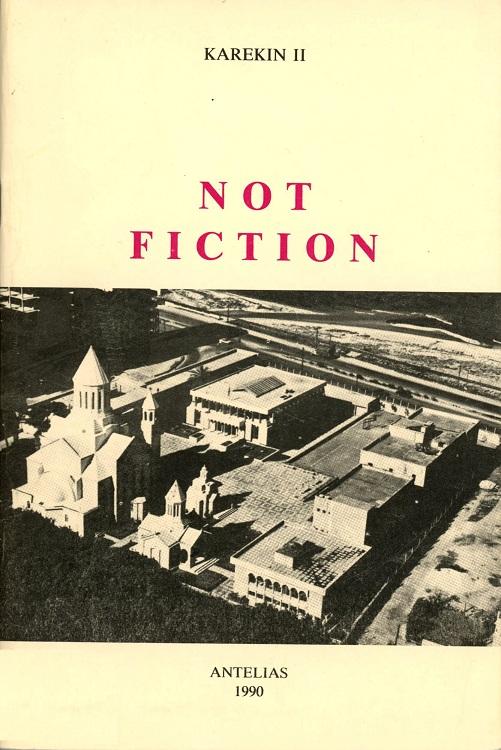 Rangement général
 | | Not Fiction |
| Titre : | Not Fiction / auteur(s) : Karekin SARKISSIAN, Catholicos Karékin II (Antélias), puis I (Etchmiadzine) - |
|---|
| Editeur : | Catholicossat arménien de Cilicie |
|---|
| Année : | 1990 |
|---|
| Imprimeur/Fabricant : | Antelias |
|---|
| Description : | 14,5 x 21 cm, 59 pages, couverture illustrée en noir et blanc |
|---|
| Collection : | |
|---|
| Notes : | |
|---|
| Autres auteurs : | |
|---|
| Sujets : | Armenian Church -- Instalation of The Catoliccossate of Cilicia at Antelias, lebanon |
|---|
| ISBN : | |
|---|
| Lecture On-line : | non disponible |
|---|
Commentaire :FOREWORDFebruary and March in this year were like hell in Lebanon. Fire was falling like rain in what is called in these years of Lebanese crisis East Beirut regions. Antelias is situated right in the middle. The Catholicosate had its full share in the destructive consequences of the recent outbreak of internal war.
During moments of agonizing fear, while trying to keep safe in a ground-floor room used for shelter, on rare occasions of pause and relative cease-fire, I found time and comfort to go through the archives of the earliest times of the establishment in Antelias of the historical Catholicosate of the See of Cilicia.
My readings prompted me to share with you the unbelievable story of the new beginnings of the Catholicosate here in Antelias. Indeed, I was fascinated by the spirit of such men, both clerical and lay, whose faith and dedication once more and so strongly impressed me and gave unprecedented courage in moments that were so conducive to despair.
The following pages were composed in such moments of anxiety, often at late night and under candle light! While reading and writing, I felt that anxiety and perplexity were giving way to courage and hope.
In publishing them under this pamphlet form, I just want to share them with friends and people of good will and genuine concern.
Another thought that prompted me to put in print what I was moved to write is related to the fact that this year, 1990, is the sixtieth anniversary of the re-establishment in Antelias of the Catholicosate of Cilicia, and, at the same time, the 50th anniversary of the consecration (10th March, 1940) of the Cathedral of St. Gregory the Illuminator which is my birth place in the priesthood of God and in my service to my people.
May God receive it as a humble act of gratitude.
KAREKIN II CATHOLICOS OF CILICIA
31st March, 1990
Feast of St. Gregory the Illuminator
"Day of Pilgrimage" of Antelias. |
371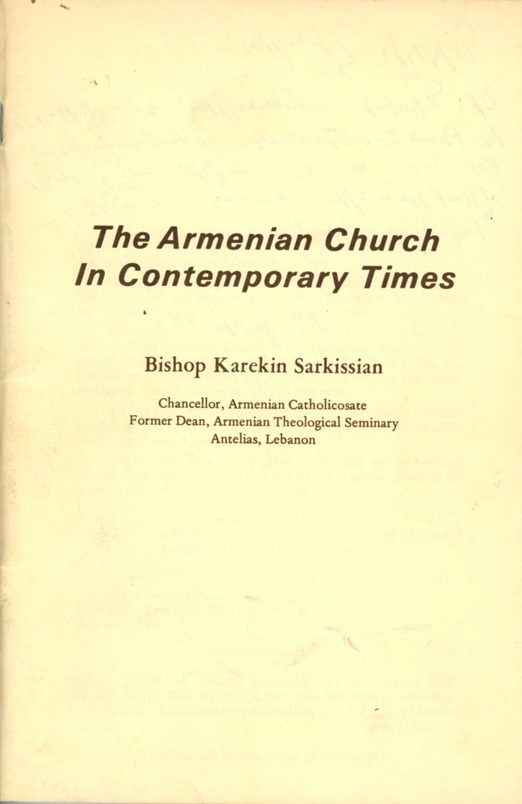 Rangement général
 | | The Armenian Church in contemporary times |
| Titre : | The Armenian Church in contemporary times / auteur(s) : Karekin SARKISSIAN, Catholicos Karékin II (Antélias), puis I (Etchmiadzine) - Bishop Karekin Sarkissian, Chnacelor, Armenian Catholicossate Former dean, Armenian Theological Seminary, Antelias, Lebanon |
|---|
| Editeur : | Prelacy of the Armenian Church of America |
|---|
| Année : | 1971 |
|---|
| Imprimeur/Fabricant : | |
|---|
| Description : | 15 x 22,5 cm, non paginé |
|---|
| Collection : | |
|---|
| Notes : | |
|---|
| Autres auteurs : | |
|---|
| Sujets : | Eglise arméninienne |
|---|
| ISBN : | |
|---|
| Lecture On-line : | non disponible |
|---|
Commentaire :Acknowledgement This chapter on The Armenian Church, by Bishop Karekin Sarkissian is reprinted from RELIGION IN THE MIDDLE EAST, edited by A.J. Arberry; published by CAMBRIDGE UNIVERSITY PRESS (1969). (Reprinted by permission of the publisher)
FOREWORD
Any serious student of The Armenian Church discovers quickly that study of our church is not possible without concurrent study of our national fortunes.
Here, in an informative and analytic fashion, Bishop Sarkis-sian, a devoted and dispassionate scholar, places our church today against the backdrop of history and into a credible composite.
Bishop Sarkissian was asked by Editor Arberry to write the chapter "The Armenian Church in Contemporary Times" for the recently published "Religion of the Middle East." In a clear and concise style, he has traced our beginnings to the last two centuries which occupy the greater part of this work.
We feel that this reprint will be particularly valuable to thinking Armenians who strive to develop institutions through which to preserve and enrich our national identity.
It is the committee's hope.that the booklet will be read and shared. They further hope that it will have a catalytic effect on the growing cohesivness of our community.
Publications Committee
ARMENIAN APOSTOLIC CHURCH OF AMERICA
Archbishop Hrant Khatchadourian, Prelate
777 United Nations Plaza New York, New York 10017 October, 1970 |
187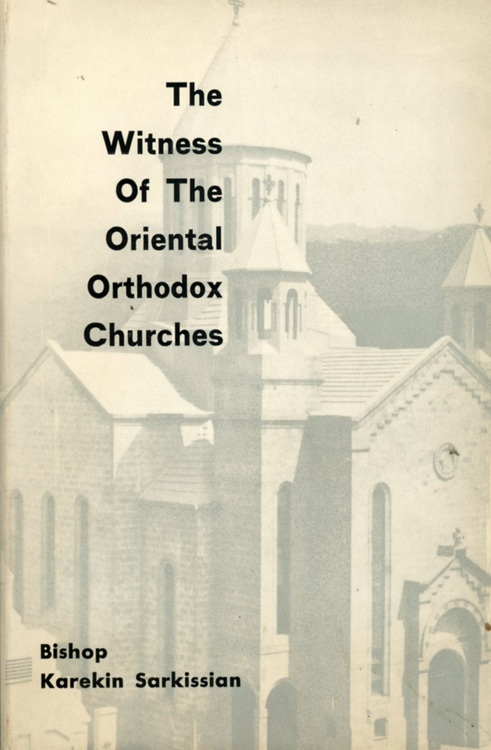 Rangement général
 | | The Witness of the Oriental Orthodox Churches |
| Titre : | The Witness of the Oriental Orthodox Churches / auteur(s) : Karekin SARKISSIAN, Catholicos Karékin II (Antélias), puis I (Etchmiadzine) - |
|---|
| Editeur : | Bishop Karekin Sarkissian |
|---|
| Année : | 1968 |
|---|
| Imprimeur/Fabricant : | Beirut |
|---|
| Description : | 14,5 x 21,5 cm, 94 pages, couverture illustrée en noir et blanc |
|---|
| Collection : | |
|---|
| Notes : | |
|---|
| Autres auteurs : | |
|---|
| Sujets : | Armenian Church -- Ecumenism |
|---|
| ISBN : | |
|---|
| Lecture On-line : | non disponible |
|---|
Commentaire :FOREWORDBishop Sarkissian examines in this study the problems and prospects of the « Oriental Orthodox Churches ». Because confusion may arise from the fact that the Orthodox Churches of the East which derive their spirituality and liturgy from Byzantium and which are in thorough communion with one another also call themselves « Eastern Orthodox Churches », and because the words « Oriental * and « Eastern * really mean the same thing so that their employment is not enough to differentiate these two groups of Churches, I prefer the use of the more Precise term « non-Chalcedonian Churches > to denote the bodies here treated by Bishop Sarkissian. He himself recognizes that this term is also used of the subject matter of his inquiry and that the plain historical fact is that these Churches « rejected » the definitions of the Council of Chalcedon, which met in 451, about the one person and the two natures of Jesus Christ. Thus the Council of Chalcedon reached certain conclusions which Rome and Constantinople and the Churches that remained subsequently in communion with them integrally accepted as inalienable articles of faith and fully incorporated into their liturgies, while certain other Churches, the linear descendants of which being here considered by Bishop Sarkissian, did not accept these conclusions nor did they incorporate them into their liturgies; it is then correct to call the one family, the Chalcedonian, and the other, the non-Chalcedonian Churches.
The problem as between the Chalcedonian (both in the East and in the West) and the non-Chalcedonian Churches is quite different from that between Catholicism and Orthodoxy, or between Rome and Constantinople. Constantinople and Rome did not separate from each other on the basis of the one affirming and the other rejecting the decrees of an ecumenical council; whereas the non-Chalcedonian Churches are distinguished from both Rome and Constantinople and their respective traditions on precisely such a basis, Catholicism and Orthodoxy both affirm equally the same decrees arrived at by all the Councils attended by both of them; whereas the non-Chalcedonian Churches came out from the Council of Chalcedon repudiating its findings. The ecumenical question today between Rome and Constantinople is therefore to be posed quite differently from that between either of them and their non-Chalcedonian brethren. In this age of openness and mutual trust no question in the relations between Churches, no matter how delicate or difficult, cannot be raised and discussed, and, under the all-conquering power of the Holy Ghost, faced and resolved.
Regardless of what happened at Chalcedon, politically and psychologically, and regardless of the rights and wrongs in the dogmatic sphere (and I as an Orthodox and therefore a Chalcedonan affirm with my Church the two distinct natures and the unitary person of Jesus Christ), I thank God that there are today, as Bishop Sarkissian so vividly describes, 22 million people baptized in the name of the Father and the Son and the Holy Ghost, descendants of Churches which, though separated from my Church after the Council of Chalcedon, were in full communion with us up till then, and fully subscribed and continue to subscribe to the tenets of the first three Ecumenical Councils, those of Nicaea, Constantinople and Ephesus; Churches whose adherents are to be met with today almost everywhere in the world, but principally in Ethiopia at the heart of Africa, in India at the heart of Asia, in Egypt at the heart of the Middle East, and in Soviet Armenia. The account of the impact of Jesus Christ upon history is full of miracles; none is greater than how these communities have outlived so much estrangement and doom. Here is a phenomenon of the most momentous significance for the total Body of Jesus Christ — 22 million Christians rooted in the human and cultural soil of some of the most strategic regions on earth, having survived untold onslaughts and Persecutions, basing themselves on the same Holy Bible of the Orthodox, Catholics and Protestants, and wholly faithful to what was delivered to them by at least the first three Councils. What they can do in time for their peoples, cultures and regions, and indeed for the whole world, by way of fermenting and leavening them with the redeeming spirit of Christ, and of remaining ever faithful in their witness to the crucified and resurrected Lord, may prove indeed incalculable. God wastes nothing, and therefore the Holy Ghost in his cosmic economy must have had a special design in preserving these islands of Christian witness and faith across the centuries. By every human and sociological measure these remnants of Christian culture should have perished long ago, reduced and absorbed by their more powerful surroundings, and yet here they are, not only resistant and alive, not only celebrating the Holy Eucharist and mediating the means of grace as they have done for centuries, not only doing all this without any appreciable help, material or spiritual, from the rest of the Christian world (nay often in the face of abandonment and even at times hostility on the part of this world), but full of hope and promise for the future. I thank God through Jesus Christ for the Ethiopians and Copts and Armenians and Indian Syrian Orthodox and other believers in the one Lord and Savior, who however for all sorts of human frailties and errors for which they and their ancestors were not alone to blame, have not been for fifteen centuries, to our loss and to theirs, in communion with the rest of the Body of Christ.
And I thank God through Jesus Christ that today « in the fulness of the time » they are rediscovering one another, they are rediscovering the rest of their Christian brethren, and we are rediscovering them. Their horizon of discovery — or rather rediscovery — discloses five exciting realms : they are rediscovering themselves — their distinctive traditions and spiritualities — studying, deepening and strengthening them; they are rediscovering one another -- and Bishop Sarkissian's account of the joy and zest of this discovery when they came together in Addis Ababa in January, 1965 « for the first time since the fifth century » is most moving; they are rediscovering and rethinking their organic relations to their immediate environments; they are rediscovering the rest of the Body of Christ, through contacts, visits, studies, and by participating as full members in conferences of the World Council of Churches and as honored and active observers in Orthodox and Catholic gatherings; and, in the interest of unity to which they as well as all of us feel drawn by the Holy Ghost, they are gradually moving, in dignity and in truth, and in a spirit of charity towards their other fellow Christians, to a serious and responsible reconsideration of their position on the great Chalcedonian issues. In this exciting climate of discovery they are justified in entertaining great expectations from the future.
I wish to call attention to the positive contributions which Bishop Sarkissian expects from these Churches—their monastic traditions, their distinctive Oriental spirituality, their deep liturgy—so full of pathos and drama and transcendental yearing, their emphasis on the Eucharistic Sacrifice, what it means and what it takes to survive despite being a beleaguered and abandoned minority, what it means to be identified with people and culture and soil and remain Christian. Here we have themes to be profoundly pondered and for which we should be thankful.
Until the great Chalcedonian controversies are squarely faced and straightened out with a view to the truth and the will of Christ alone, and above all particular historical determinations, there is no end to what can be done between these Churches and the rest of us in all sorts of practical endeavors—social, economic, educational, intellectual, and in the service of peace. The dialogue in this age of the explosion of the Holy Spirit must continue and deepen at all levels.
The ^findings and decisions* of the historic Addis Ababa Conference of 1965 which Bishop Sarkissian Publishes as an appendix to this work are worthy of special study. There is here a spirit of modernity and renewal and responsibility, and there is a devotion to Jesus Christ, which will do credit to any Church. I wish to quote here in full one of these decisions :
« Concerning the Christological controversy which caused the division [ at the Council in 451 on the two distinct natures and the one unitary person of Jesus Christ 1, we hope that common studies in a spirit of mutual understanding can shed light on our understanding of each other's positions. So we decide that we should institute formally a fresh study of the Christological doctrine in its historical setting to be undertaken by our scholars, taking into account the earlier studies on this subject as well as the informal consultations held in connection with the meetings of the World Council of Churches. » (p. 109)
This is a humble, inoffensive and exceedingly conciliatory statement. It is wholly in keeping with the spirit of the ecumenical age. I understand that these studies have been proceeding. May they reveal when completed in God's own day that, abstraction being made from all sorts of accidental personal and political matters, which can now be understood and forgiven and risen above, much of the residual doctrinal estrangement arose from misunderstanding. May this misunderstanding be frankly set forth and recognized and therefore overcome by all concerned. May all of us implore the Holy Ghost on our knees to guide us in the ecumenical dialogue in absolute humility and love, and in total abandon to the certain will of Christ. The end is not the glory of man or this or that culture or this or that Christian community. The end is the glorification by us sinners of Jesus Christ before all men. The end is, as Christ himself prayed, that all who believe in him may be one, to the end that the world—this fallen, miserable, struggling, groping, drifting, proud, disintegrating world—may believe that God the Father had sent him. I find reconciliation and unity the simplest thing in the world if only men love Jesus Christ above everything else, and fix only on his Cross and his Resurrection. CHARLES MALIK
Rabiya, Lebanon October 30, 1968 |
186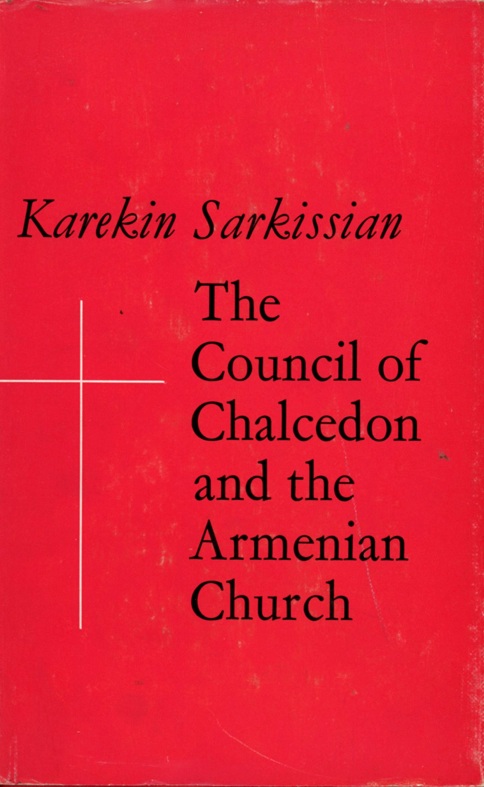 Rangement général
 | | The Council of Chalcedon and the Armenian Church |
Commentaire :FOREWORDThis book was written five years ago as a thesis for the degree of B. Litt. in the University of Oxford.
The text has undergone no substantial change since then. The only addition has been the last chapter, in which I have tried to draw up certain conclusions with an ecumenical perspective and I have indicated some general lines for future studies concerning the historical and theological situations subsequent to and closely related to the period and the problems under study in this treatise.
I need not emphasize the importance of a study treating the early christological controversies which have had a permanent effect on the Christian Churches, particularly in the East. In fact, the clash between the two main traditions of christological thinking in the early Church, usually described as the "Alexandrian and Antiochene Schools", interwoven as it was with other factors of personal, ecclesiastical, and political nature, finally resulted after the Council of Chalcedon (A.D. 451) and particularly in the first half of the sixth century in the formation of two distinct, separate groups of Churches within the fold of Eastern Christendom: the Chalcedonian Churches under the protection of the Byzantine Empire, and the anti-Chalcedonian Churches within or outside the Byzantine Empire with a strong tendency towards an independent status of life. The latter group of Churches, mistakenly and misleadingly often depicted as "Monophysite Churches"—i.e. the Syrian, Coptic, Ethiopian, and Armenian Churches—have continuously maintained firm their doctrinal position throughout their history. The Churches of Byzantine tradition and origin have recognized them for many centuries as heretical or schismatic Churches. But thanks to sincere and serious attempts made in mutual understanding and in an atmosphere free from polemical heat and historical prejudices many of the misunderstandings have fallen away. Owing to the present ecumenical spirit that breathes in the Christian Churches all over the world, these two groups of Churches have come to recognize their unity in faith in the very depth of their christological confession. Fears of heresy or alienation from Christian truth that lay behind the minds of the leading theological figures of these Churches have disappeared in the course of their long experience of Christian faith and life in history. Political and other related factors have disappeared equally. Recently, some positive signs are emerging with regard to the possibility of mutual understanding and recovery of the lost sense and state of unity or communion. Thus, the study of the Council of Chalcedon has become an item of genuine interest at the present time. My sincere belief is that any objective and deep-searching inquiry into the history and theology of Chalcedon and post-Chalcedon may be a help towards a deeper understanding of the most essential area of our common heritage of Christian faith: christology.
It is with this desire in heart and with this view in mind that I present this work to its readers, who will find a fuller presentation of the nature and the scope of this study in the Introduction that follows.
Before concluding this brief word of opening, I should like to express my feelings of joy and gratitude in thanking many of my friends who in one way or another have helped towards the preparation and publication of this book. First of all, I should say a special word of thankful recognition in memory of my Supervisor, the Reverend C. S. C. Williams, the late Chaplain of Merton College, Oxford, whose constant support and help have meant so much to me and have contributed so greatly to the improvement of my work. My hearty thanks are due also to the Right Reverend F. J. Taylor, Principal of Wycliffe Hall (now the Lord Bishop of Sheffield), who provided me with all the facilities for quiet study in Wycliffe Hall where I had the pleasure of sharing in the life of Anglican theological students for two years. I take much pleasure in thanking my examiners, the Reverend Dr H. Chadwick, Regius Professor of Divinity in Oxford University and Dr C. J. F. Dowsett, Lecturer in Armenian in the School of Oriental and African Studies of London University, who carefully read the text and made valuable suggestions at the same time encouraging me to publish the work. Finally, it is with deep satisfaction and appreciation that I should like to express my thanks to the Calouste Gulbenkian Foundation as well as to the Harold Buxton Trust for their generous financial contribution towards the publication of the book. KAREKIN SARKISSIAN
Antelias, Lebanon, 25 November 1964. |
|
